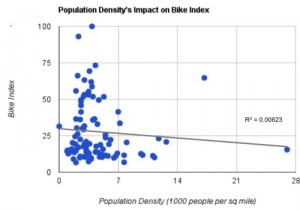
At first we were convinced that 100 percent of the variance in bike market size could be explained by the population density of a city. If you live an a densely populated area like San Francisco, bicycling is an efficient way to get around the city. If you live in Los Angeles, getting on a bicycle can’t really get you anywhere. To our surprise, population density has a nearly zero correlation with our bicycle index. If anything, it very weakly suggests the more densely populated the city, the less prevalence of biking.
That’s from a post titled “The Fixie Bike Index,” on the Priceonomics Blog.
If, like me, you are nowhere near hip enough to know what a fixie is, let me spare you a Google search: a fixie is a fixed-gear bicycle, which is apparently a much-coveted item among hipsters. That’s right: grown men and women enjoy riding around town on a bike like the one you and I used to ride when we were 8 years old.
That being said, let’s go back to the image above. Note how the above-referenced post explains how “population density has a nearly zero correlation with our bicycle index,” which, “[i]f anything, (…) very weakly suggests the more densely populated the city, the less prevalence of biking.”
I guess someone missed the lecture on how sensitive the mean is to outliers back in college. A quick look at the scatter plot and regression line above indicate that the latter is driven by the point on the far right.
Remove that point, and it looks like there might be a positive relationship between a city’s bike index and the density of its population. Trim all four outliers, and it’s really not obvious what is going on.
Surely there’s a bookshop in Williamsburg that has a used copy of Kennedy’s Guide to Econometrics for sale?
(HT: @mungowitz‘s snark, which is not to be confused with Echidna’s Arf.)
Hipstermetrics
At first we were convinced that 100 percent of the variance in bike market size could be explained by the population density of a city. If you live an a densely populated area like San Francisco, bicycling is an efficient way to get around the city. If you live in Los Angeles, getting on a bicycle can’t really get you anywhere. To our surprise, population density has a nearly zero correlation with our bicycle index. If anything, it very weakly suggests the more densely populated the city, the less prevalence of biking.
That’s from a post titled “The Fixie Bike Index,” on the Priceonomics Blog.
If, like me, you are nowhere near hip enough to know what a fixie is, let me spare you a Google search: a fixie is a fixed-gear bicycle, which is apparently a much-coveted item among hipsters. That’s right: grown men and women enjoy riding around town on a bike like the one you and I used to ride when we were 8 years old.
That being said, let’s go back to the image above. Note how the above-referenced post explains how “population density has a nearly zero correlation with our bicycle index,” which, “[i]f anything, (…) very weakly suggests the more densely populated the city, the less prevalence of biking.”
I guess someone missed the lecture on how sensitive the mean is to outliers back in college. A quick look at the scatter plot and regression line above indicate that the latter is driven by the point on the far right.
Remove that point, and it looks like there might be a positive relationship between a city’s bike index and the density of its population. Trim all four outliers, and it’s really not obvious what is going on.
Surely there’s a bookshop in Williamsburg that has a used copy of Kennedy’s Guide to Econometrics for sale?
(HT: @mungowitz‘s snark, which is not to be confused with Echidna’s Arf.)
Share this:
Published in Commentary, Econometrics, Methods and Social Sciences